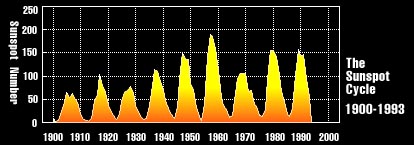|
The Sunspot Cycle
In the last few decades, the forces
behind sunspots are becoming better understood, but we've known for over
a 150 years that sunspots appear in cycles. The average number of visible
sunspots varies over time, increasing and decreasing on a regular cycle
of between 9.5 to 11
 years, on average about 10.8 years. An amateur
astronomer, Heinrich Schwabe, was the first to note this cycle, in 1843.
The part of the cycle with low sunspot activity is referred to as "solar
minimum" while the portion of the cycle with high activity is known
as "solar maximum."
years, on average about 10.8 years. An amateur
astronomer, Heinrich Schwabe, was the first to note this cycle, in 1843.
The part of the cycle with low sunspot activity is referred to as "solar
minimum" while the portion of the cycle with high activity is known
as "solar maximum."
By studying the sun's magnetic field, modern
astronomers have discovered that the cycle covers twenty-two years, with
an eleven-year cycle of sunspots above the equator followed by an equal
cycle below the equator. According to Fisher, "the overall magnetic
field structure changes in a way that is very interesting: It turns out
that the magnetic fields primarily point from west to east in the Northern
Hemisphere (of the sun), and from west to east in the Southern Hemisphere.
In the next eleven-year cycle, the fields are reversed. So the cycle is
really twenty-two years."
Sunspots most often appear in the low latitudes
near the solar equator, and they almost never appear below 5 or above 40
degrees north and south latitude. As the sunspot cycle progresses, the visible
sunspots move gradually towards the equator.
From 1645 to 1715, there was a drastically
reduced number of sunspots. This period of reduced solar activity, which
was first noticed by G. Sporer and was later investigated by E.W. Maunder,
is now called the Maunder Minimum. This period of time was also unusually
cold on earth, and it has been referred to as the "Little Ice Age."
This has led to some speculation that sunspot activity may affect the earth's
climate. Similar periods of low solar activity seem to have occurred during
the Spoerer Minimum (1420-1530), the Wolf Minimum (1280-1340), and the Oort
minimum (1010-1050).
Solar astronomers
label solar cycles from one minimum to the next, and assign them numbers,
starting at one, with the 1755-1766 cycle.
|
